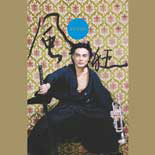Eso de..
me a llegado al corazónEste disco se puede considerar experimental, fílmico, evocador... no lo recomendaría a todos los estómagos.



yo he leido por ahi que se prepara un disco de RAPhari escribió:Otra casualidad, Nurse with wound han estado a puntito de tocar en barcelona. Que pena que lo han cancelado
La légende d'Eer is a powerful 7-channel electro-acoustic composition which Xenakis created in 1977-78 to be played in "Le Diatope", a curvaceous architectural construction designed by the composer, together with a visual component including laser lights. This "multi-media" work was composed for the opening of the Centre Georges Pompidou in Paris, where it was performed for three months and seen by thousands of people.
It is difficult to think of another contemporary composition which carries the sheer force of 'The Legend of Eer.' It is a gigantic, awesome, staggering piece; certainly I haven't heard anything to touch it with electronic music's short, if dense, history. The DVD-A version is forthcoming.
--- Richard Scott, The Wire
The music of Iannis Xenakis can be grating on the nerves of any music lover, but the harsh worlds he creates in his works are also accompanied by incredible beauty and serenity (though some listeners do not give enough attention to Xenakis to find the beauty in his works). His electronic music is daring and exciting, La Légende d'Eer is an powerful epic work and it is not for the faint of heart.




Posteado por TombStone en MusicMule.Brian Lustmord's short biography:
During the seven year absence Lustmord's legendary Brian Williams concentrated on other activity, including collaborative projects and work as Music Sound Designer for over thirty Hollywood motion pictures, including The Crow; Strange Days; From Dusk Till Dawn; The Craft; Spawn; The Negotiator; Bride of Chuckie; The Siege; The Insider and Pitch Black while more recently he has been composing music for Television and Video Games. Active in music for over twenty years under the name Lustmord, Brian first gathered attention as part of the small group of individuals that spawned the original "industrial" music scene out of the United Kingdom in the late seventies.
The two albums quickly established his reputation as one of the leaders in the genre of atmospheric "ambient" music with his use of diverse recording sources such as cosmological activity, caves, crypts and catacombs, and later recordings utilized extensive computer manipulation of natural recordings, and are credited as single-handedly creating the "dark ambient" movement, with Lustmord albums have appeared on numerous "all time top ten" and "best" lists, both in print and on the internet. In the early eighties he was a member of SPK, one of the most influential groups of the industrial music genre, and from 1985 until 1999 owned and managed the record label, Side Effects and served as a technical and artistic consultant for Mute Records (London). He has collaborated on projects with a diverse group of artists including Clock DVA, John Balance (Coil), Robert Rich, Paul Haslinger (Tangerine Dream), Jarboe (The Swans), Monte Cazazza and Chris & Cosey, as well as touring extensively throughout Europe and America as both performer and technician.

Evan Parker’s EAE are the result of the saxophonist’s long held interest in electro-acoustic processing. Alongside Parker’s usual trio (augmented with piano and violin), there are no less than four people engaged in capturing and treating the realtime playing with all manner of digital trickery. Parker avoids the unholy mess this could have become by structuring Memory/Vision as a series of solos and small scale groupings. The acoustic instruments are ghosted into new shapes by filtering, looping and pitchshifting. Barry Guy’s bass plucks bounce back as tiny high register blips; Philipp Wachsmann’s violin is looped into long melodic curls, while Evan’s soprano flutterings peel off into wisps of sour melody. … The results range from cool, pastoral ambience to episodes of slightly mournful abstract twittering. This is music that hangs in the air, sometimes vaporous, sometimes almost sculptural in its weight. Parker’s structures make this a rewarding (and repeatable) experience, and the spacious, pristine production gives each sound room to breathe. Luscious, alien stuff, and utterly beautiful.
Evan Parker: soprano saxophone, tapes and samples
Philipp Wachsmann: violin, electronics
Agustí Fernandez: piano, prepared piano
Barry Guy: double-bass
Paul Lytton: percussion, electronics
Lawrence Casserley: signal processing instrument
Joel Ryan: computer, sound-processing
Walter Prati: electronics, sound-processing
Marco Vecchi: sound processing, electronics





hombre, si son criticas del go o el ab, pues no te digo que no, pero afortunadamente hay gente que si es capaz de hacer critica acertada de este tipo de musicaArcadia_Ego escribió:Lustmord es la ostia.
La gracia está en descubrirlos por ti mismo (via Soulseek) y NUNCA hacer caso a las críticas. Esta música tiene de todo menos semántica, por lo que la crítica es vacua en cualquier caso (a no ser que técnicamente sea una chufla, cosa que no suele pasar pq se suele hacer por software casi siempre).